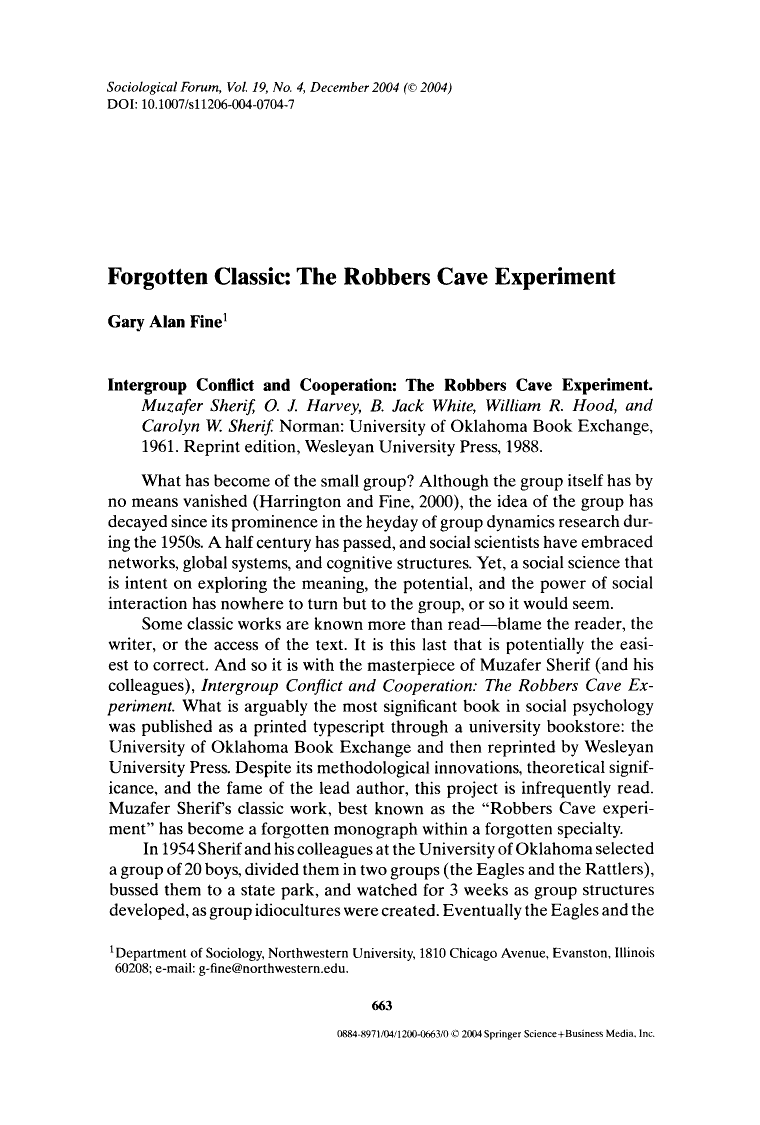The Robbers Cave Experiment, conducted by social psychologist Muzafer Sherif and his team in 1954, was a landmark study investigating intergroup conflicts and group dynamics. It was carried out at Robbers Cave State Park in Oklahoma over three weeks and involved 22 11-year-old boys. The experiment is a classic illustration of intergroup conflict, cooperation, and resolution.
The Setup:
1. Stage 1: Formation of Groups: The boys were divided into two separate groups: the Eagles and the Rattlers. They were kept isolated from each other, unaware of the other group’s existence.
2. Group Cohesion Development: Over a week, each group formed strong bonds and developed their unique identities through team-based activities.
3. Intergroup Introduction: The two groups were introduced to each other in a competitive setting. This immediately led to hostility and conflict between the groups.
The Conflict Phase:
1. Competition and Hostility: The experimenters created situations where the groups competed against each other for resources. This competition intensified the hostility and led to the development of negative stereotypes about the opposing group.
2. Escalation of Conflict: As the competition continued, the boys exhibited increased hostility, with verbal insults and physical confrontations. The groups developed strong in-group loyalty and began to discriminate against the other group.
Resolution Phase:
1. Superordinate Goals: Sherif introduced tasks that required the cooperation of both groups to achieve common goals. For instance, a problem that could only be solved if both groups worked together.
2. Reduced Conflict: As the groups cooperated to achieve these shared goals, the hostility diminished. They began to see each other in a more positive light.
3. Fusion and Integration: The boys developed friendships across groups, and the hostility significantly decreased. The experiment demonstrated that working together towards common objectives reduced intergroup conflict.

Further References
Sherif, M., Harvey, O. J., White, B. J., Hood, W. R., & Sherif, C. W. (1988). The Robbers Cave experiment: Intergroup conflict and cooperation . Middletown, CT: Wesleyan University Press.
Sherif, M. (1966). In common predicament: Social psychology of intergroup conflict and cooperation . Boston: Houghton Mifflin.
This experiment is crucial in understanding group behavior, conflict resolution, and the conditions that foster cooperation among conflicting groups. It sheds light on the importance of shared goals in reducing intergroup hostility and fostering harmony.
- Muzafer Sherif, C. W. Sherif: Experimentelle Untersuchungen zum Verhalten in Gruppen. In: J.-J. Koch (Hrsg.): Sozialer Einfluss und Konformität. Beltz Verlag, Weinheim und Basel 1977, S. 167–192.
- M. Sherif, C. W. Sherif: Social Psychology (Int. Rev. Ed.). Harper & Row, New York 1969.
- M. Sherif, O. J. Harvey, B. J. White, W. R. Hood, C. W. Sherif: Intergroup conflict and cooperation: the Robbers Cave experiment. University of Oklahoma Book Exchange, Norman 1961.
- M. Sherif, B. J. White, O. J. Harvey: Status in experimentally produced groups. In: American Journal of Sociology. Band 60, 1955, S. 370–379.
- M. Sherif, C. W. Sherif: Groups in harmony and tension. Harper & Row, New York 1953.
See also: psychclassics.yorku.ca/Sherif/




![Plato's Allegory of the Cave ea35b7062ef5083ecd0b4401ef444f94eb6ae3d01db3144992f3c97d_640[1]](https://cognitive-liberty.online/wp-content/uploads/ea35b7062ef5083ecd0b4401ef444f94eb6ae3d01db3144992f3c97d_6401-222x300.png)

![Groupthink ea34b40d2dfc043ecd0b4401ef444f94eb6ae3d01db316439df9c67b_640[1]](https://cognitive-liberty.online/wp-content/uploads/ea34b40d2dfc043ecd0b4401ef444f94eb6ae3d01db316439df9c67b_6401-300x200.jpg)

![Solom Aschs studies of conformity ed32b30f2de91c72d15e4c0def4e4e8be272e6d71eb017439cf4_640[1]](https://cognitive-liberty.online/wp-content/uploads/ed32b30f2de91c72d15e4c0def4e4e8be272e6d71eb017439cf4_6401-300x268.png)